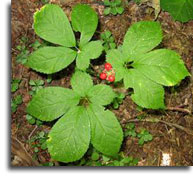
From Riches to Rarity
American ginseng (Panax quinquefolius) has a rich history in North America. Native Americans used the roots medicinally for years, and European colonists quickly revered the roots as well. American ginseng was one of the earliest American exports to China. Entrepreneurs such as John Jacob Astor bought and sold roots to amass their fortunes. Even today, American ginseng is prized for its medicinal qualities and is still harvested and sold internationally. In the early days of the American ginseng trade, ginseng was abundant throughout much of the deciduous forests in the eastern United States. Unfortunately, it has dramatically declined throughout much of its range.
Description and Range
American ginseng is a slow growing, long lived understory plant found within eastern deciduous forests of North America. Ginseng begins its lifecycle as a seedling with a single compound leaf (also known as a prong). As the plant ages, it typically forms more prongs. Juvenile plants tend to have two prongs while adult plants tend to have 3 to 4 prongs. Rarely, adult ginseng plants can have 5 or more prongs.
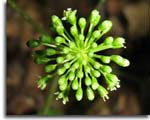 Ginseng generally takes 3 to 8 years to reach sexual maturity. Sexually mature (or reproductive) plants will produce a single cluster of flowers, also known as an umbel, in early spring. The flowers on the outside of the umbel open first while those in the center of the umbel open last. The flowers can either be self fertilized, or they can be cross pollinated with other plants. There are two known pollinators of ginseng: syrphid flies and halictid bees.
Ginseng generally takes 3 to 8 years to reach sexual maturity. Sexually mature (or reproductive) plants will produce a single cluster of flowers, also known as an umbel, in early spring. The flowers on the outside of the umbel open first while those in the center of the umbel open last. The flowers can either be self fertilized, or they can be cross pollinated with other plants. There are two known pollinators of ginseng: syrphid flies and halictid bees.
Typically, plants which are visited by pollinators have higher seed production. Following pollination, fertilized flowers will develop into green berries which later turn red at maturity. Each berry contains 1-3 seeds. The seeds will germinate after 18-20 months.
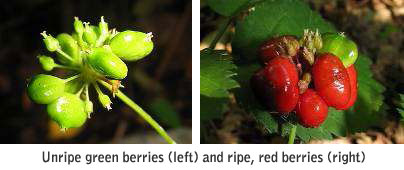
American ginseng can be found from Maine west to Ontario and Manitoba, south to Alabama, Louisiana, and Kansas. In Maryland, its range is mainly restricted to the western portion of the state, including Allegany, Frederick, Garrett and Washington counties. Small, remnant populations have also been reported, at least during the last 20 years, on the coastal plain and in the piedmont.
Why is American ginseng declining? 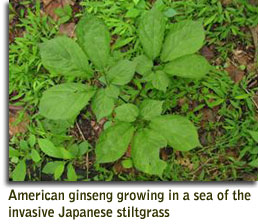
Multiple factors have contributed to the decline of American ginseng. Some of these factors include:
- Habitat loss
- Overharvest
- Browsing by white-tailed deer
- Invasive species
Habitat loss through logging, agriculture, mountaintop mining and development has rendered many areas unsuitable for American ginseng. In addition, overharvest and poor harvest practices (harvesting non-reproductive plants or those without ripe fruits) has led to a sharp decline in existing populations. Furthermore, studies have found that browsing by white-tailed deer can have significant population impacts as deer often browse large, reproductive plants before they can produce seeds. Since American ginseng is slow-growing and produces few seeds, the loss of one reproductive plant before it has a chance to produce seeds can have large impacts on small populations of ginseng. Finally, the growing threat of invasive species within areas that support American ginseng is another problem. Certain invasive species outcompete American ginseng for limited resources while others, like garlic mustard, alter soil environments to make it unsuitable for American ginseng growth.
What is being done to protect American ginseng?
Due to the decline of American ginseng, it was included in Appendix II of the Convention on International Trade in Endangered Species of Wild Fauna and Flora (CITES) in 1975. As a result of the listing, individual states have to maintain records of annual harvests, set harvest dates, and have to certify roots for sale through licensed dealers with oversight from the U.S. Fish and Wildlife Service (USFWS). The USFWS is tasked with evaluating individual states’ ginseng management programs and determining if the state can continue ginseng harvest programs. The USFWS also holds meetings bringing scientists and stakeholders together. A summary of the federal laws and regulations relating to ginseng as well as findings from recent meetings can be found on the USFWS American Ginseng page.
American ginseng can be found in 34 states, 21 of which list it as a conservation concern. Fifteen states prohibit the harvest and sale of wild ginseng while the remaining 19 states allow the harvest and export of wild ginseng, as long as they fulfill Federal and CITES mandates.
Currently, American ginseng is listed as rare to uncommon in Maryland. Recent field surveys and harvest records indicate that this species is declining in the state. In 2012, systematic surveys were conducted on multiple state owned lands to assess the status of ginseng and its populations. The surveys revealed several small, isolated populations of American ginseng with few adult (reproductive) plants. In addition, the recent price increases for wild harvested roots has led to more harvest permits in Maryland, indicating the likelihood of increased harvest pressures. Due to these surveys, it was determined that continued harvest of American ginseng on state lands was not sustainable. Therefore, in March 2013, the Maryland Department of Natural Resources enacted a harvest prohibition for state owned lands. American ginseng still can be harvested from private properties. To learn more about Maryland harvest regulations, please click here.
Why is it Important to Conserve American ginseng?
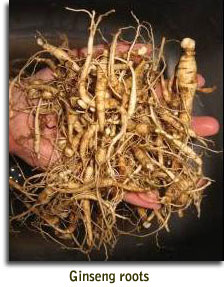 For centuries, Asian medicine has used ginseng to treat insomnia, fatigue, and digestive problems. Because of its medicinal popularity, the sale and export of American ginseng is a multi-million dollar industry in the United States. Ginseng roots harvested from plants growing in the wild fetch the highest price tags, but cultivated ginseng is also sold on the market.
For centuries, Asian medicine has used ginseng to treat insomnia, fatigue, and digestive problems. Because of its medicinal popularity, the sale and export of American ginseng is a multi-million dollar industry in the United States. Ginseng roots harvested from plants growing in the wild fetch the highest price tags, but cultivated ginseng is also sold on the market.
In addition to being economically important, American ginseng also is a culturally significant plant as its harvest and use history intertwines with rural Appalachian culture. “Sang” hunting is an Appalachian tradition that has been passed down through many generations. American ginseng use also has been growing in popularity as a complementary medicine.
In a biological sense, American ginseng is part of our natural heritage and is an important understory herb. American ginseng also has been used as an ecological indicator species to help assess the health of certain forest systems.
What can be done to help American ginseng?
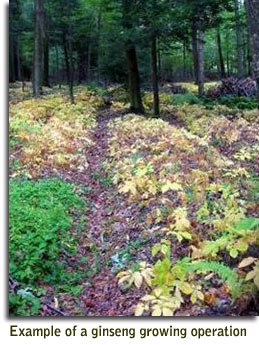 One way to conserve American ginseng is to promote growing operations. The Western Maryland Research and Education Center has put together a helpful fact sheet on growing American ginseng. American ginseng can be grown in a variety of ways, including under shade cloth (“shade grown”) and in forest settings (“woods grown” or “wild simulated”.) Cultivated American ginseng is a rapidly expanding business with a growing demand. In Maryland, in order to sell ginseng seed and living plants (rootlets) outside of the state, growers have to be licensed through the Nursery Inspection Program.
One way to conserve American ginseng is to promote growing operations. The Western Maryland Research and Education Center has put together a helpful fact sheet on growing American ginseng. American ginseng can be grown in a variety of ways, including under shade cloth (“shade grown”) and in forest settings (“woods grown” or “wild simulated”.) Cultivated American ginseng is a rapidly expanding business with a growing demand. In Maryland, in order to sell ginseng seed and living plants (rootlets) outside of the state, growers have to be licensed through the Nursery Inspection Program.
When harvesting American ginseng on private lands, it is recommended to follow several good stewardship practices such as only harvesting plants with ripe (red) fruits and planting the fruits after harvesting the root. The American Herbal Products Association has information on stewardship practices here. Additionally, Maryland Law requires anyone who collects and harvests ginseng for sale to have a valid annual collecting permit. Furthermore, ginseng dealers (those who buy and sell Maryland harvested or grown ginseng) are also required to be licensed with the Maryland Department of Agriculture. For information on permits, please visit the Maryland Ginseng Management Program page.
In addition, it is not recommended to purchase and plant commercial seed in natural areas and within natural populations. Many commercial seeds are genetically distinct from wild seed, and the introduction of new genes into wild populations may have negative side effects. More information on the problems with introducing cultivated seeds into wild populations can be found on the Wild Ginseng Conservation page.
Acknowledgements:
- All photos by Kerry Wixted, MD DNR
For more information:
